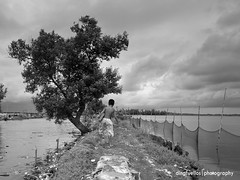 I had a chance to work again with the Cordillerans, specifically with the weaving industry. The following is an excerpt of the summary of the study I did for the Peace and Equity Foundation, CORDNET, and DTI-CAR.
I had a chance to work again with the Cordillerans, specifically with the weaving industry. The following is an excerpt of the summary of the study I did for the Peace and Equity Foundation, CORDNET, and DTI-CAR.
FOR CENTURIES, the tribal people of the Cordillera in Northern Philippines have hand-woven the rich tapestry of their culture and heritage into the tight-weave designs we see today. Each community group has their respective designs, colors, and symbolism. One can easily identify one group from another by the dresses that they wear.[i] Moreover, the blankets and articles of clothing that they produce by means of the backstrap loom not only fulfill a practical function but also play a part in religion and ritual.[ii]
Inasmuch as weaving is an important element and component of the Cordillera culture, it does not only become an alternative source of income. More importantly, it becomes a family activity. Wives, husbands and children have a role to play from, cotton separation, dyeing, drying, spinning and weaving. Back strap looms are handed down either as heirloom or as gifts from the husbands. It is a living tradition. Stores may close down but the tradition lives on.
With strong cultural exchange and influences, introduction of technology, and consumerism, the weaving industry in the cordillera faces a great challenge.
Over the years, the industry has to confront the following concerns/ issues:[iii]
- Diminishing number of or ageing skilled weavers,
- Market development –
- Enterprise management
- Product development
- Technology
- Gender equality issues on multiple role of women
- Lack of credit for the weaving industry.

Woven materials from the Cordillera have taken many forms, but sometimes, these woven materials no longer impact to buyers as something that is indigenous, and symbolic or have significant cultural meaning – it simply becomes a bag, a table runner, or a tapestry on the wall.
Amidst modernism and utilitarianism, Cordillera woven products must find its niche—one that is cultural, but also functional.
NOTES:
[i] Available at: http://www.slu.edu.ph/offices/arts_music_culture/museum/collections.jsp. Downloaded on April 21, 2007.
[ii] Available at: http://www.filipinoheritage.com/arts/visual-arts/pre-colonial-period.htm. Downloaded on April 21, 2007.
[iii] The need to validate these initial impressions would be very important in the future program assistance for the weaving industry. The separate case studies I have facilitated have validated these issues. The case studies did not intend to make a full-blown study of the entire weaving industry of the Cordillera Administrative Region. It aimed to provide a quick glance of the status of the weaving industry in the selected municipalities and specific weavers associations/ cooperatives. Information on these groups and community-specific conditions and issues would serve as the start-off point for future technical and financial assistance. Nevertheless, the study was also juxtaposed with the bigger scenario or the entire weaving industry to establish the validity of the findings, as well as to properly situate the varying conditions of the industry in each locality.
See related article at: BAGUIO CITY ONLINE, WOW BAGUIO, AND CORDILLERA ONLINE















0 people have commented. Leave your comments too!:
Post a Comment
Thank you for visiting and reading my blog! If you want to say something about this blog entry, please leave your comments below.
Please be informed that the author prevents spamming, thus the moderated comments. Nonetheless, your comments will be published after the author has reviewed them.
Bear in mind that your contact information will be kept confidential.
If you wish to send me private message, please follow this link:
http://ding-inkblots.blogspot.com/p/contact.html
Salamat! (Thank you!)